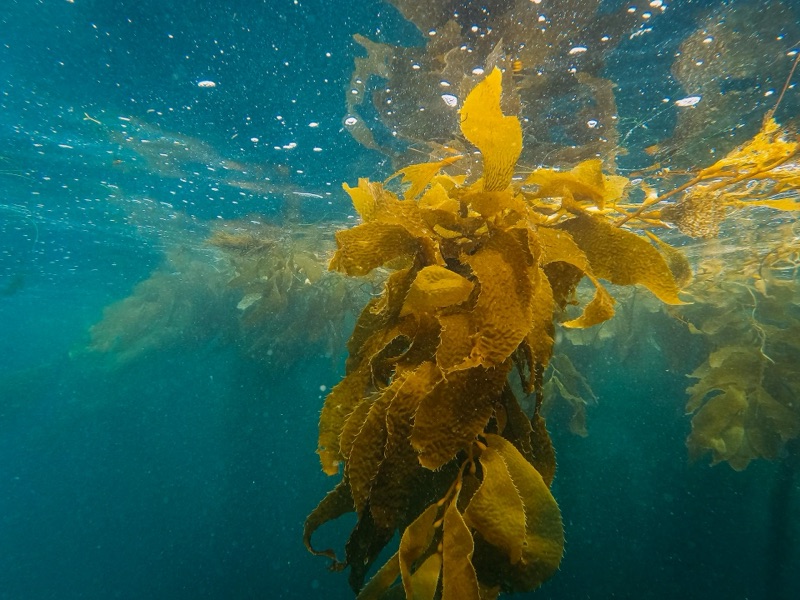Botanical Basics
- Common Name(s): Kelp, Sea Kelp
- Folk Name(s): Seaweed, Neptune’s Herb, Sea Tang
- Scientific/Latin Name: Commonly Laminaria digitata, Ascophyllum nodosum, and other brown seaweeds in the order Laminariales
- Family: Laminariaceae (Brown algae family)
- Plant Type: Large marine algae (macroalgae)
- Botanical Description: Grows in long, leathery, ribbon-like fronds with holdfasts anchoring them to rocks. Can reach up to 200 ft in giant species (Macrocystis pyrifera). Brown-green color due to chlorophyll and fucoxanthin pigments.
- Growing Zones/Climate: Cold to temperate coastal waters
- Best Zones for Growth: Thrives in nutrient-rich waters along the Pacific Northwest, North Atlantic, Japan, and Northern Europe
- Habitat & Range: Found worldwide in coastal marine environments, forming kelp forests that provide habitat for diverse species
Cultivation & Harvest
- Soil & Sun Requirements: Not soil-based; requires cold, nutrient-rich seawater with sunlight penetration
- Propagation: Reproduces via spores; cultivated on ropes or nets in aquaculture systems
- Companion Planting: Grown with shellfish (e.g., mussels, oysters) in polyculture aquaculture systems for sustainable farming
- Harvesting Guidelines: Fronds harvested sustainably by trimming rather than uprooting holdfasts; gathered year-round, though best quality in spring and early summer
- Drying/Preservation: Washed, then sun- or air-dried; ground into powders, flakes, or extracts for culinary, medicinal, and agricultural use
Traditional & Historical Use
- Cultural Significance: Used for centuries in Asia (Japan, Korea, China) as food and medicine; valued in Europe for fertilizer and iodine-rich remedies
- Traditional Medicine: Used to treat goiter (enlarged thyroid) from iodine deficiency; also applied for joint pain, skin conditions, and weight regulation
- Symbolism: Represents the ocean’s bounty, protection, and adaptability
Medicinal & Practical Properties
- Active Constituents: Iodine, alginates, fucoidan, mannitol, vitamins (A, B, C, E, K), minerals (calcium, potassium, magnesium, iron, zinc), protein, and fiber
- Medicinal Uses:
- Supports thyroid health and metabolism (iodine source)
- Detoxifying (binds heavy metals in digestive tract)
- Anti-inflammatory and immune-supportive
- Improves skin and hair health
- Aids weight management by enhancing satiety
- Preparation Methods: Dried flakes or powder in food; capsules or tablets; decoction in soups or teas; topical gels in skincare
- Dosage & Guidelines:
- Powder: ½–1 tsp daily as supplement
- Capsules: 300–600 mg standardized extract
- Culinary: Incorporated freely into soups, broths, or sushi
- Safety/Precautions: Excessive iodine intake may cause thyroid imbalance. Not advised in hyperthyroidism or with thyroid medications unless supervised. Ensure clean sourcing (can absorb pollutants from water).
Magical & Spiritual Properties
- Elemental Association: Water
- Planetary/Deity Correspondence: Moon, Neptune, Poseidon, Yemaya
- Magical Correspondences: Protection (especially for travelers), money-drawing, binding, sea-magic, purification
- Ritual Use: Carried in sachets for protection; used in prosperity spells (especially involving trade); sprinkled in baths for cleansing; burned/dried for oceanic offerings
- Symbolism in Divination/Dreams: Suggests adaptability, cleansing, and spiritual nourishment; may indicate guidance from water spirits or ancestors of the sea
Ecological & Culinary Uses
- Pollinator Value: Not pollinated (algae reproduce via spores); contributes oxygen to marine ecosystems
- Wildlife Uses: Provides food and shelter for fish, crustaceans, sea otters, and other marine species; kelp forests are vital ecosystems
- Culinary Uses: Widely eaten in Asian cuisines (kombu, wakame, kelp noodles); used in soups, broths, sushi rolls; added as seasoning or thickener (alginates in food industry)
Household/Practical Uses
- Quick Uses: Thyroid support, detoxifying supplement, fertilizer for gardens, seaweed baths for skin health
- Notable Traits: Among the fastest-growing organisms on earth (up to 2 feet per day in giant kelp)
- Special Notes: Known as “the sea’s green gold” for its nutritional richness and vital ecological role

Supporting Notes
- Chevallier, Andrew. Encyclopedia of Herbal Medicine (2016)
- Grieve, M. A Modern Herbal (1931)
- Chapman, V.J. Seaweeds and Their Uses (1970)
- Teas, Jane. “The dietary value of seaweeds.” Nutrition and Cancer (1983)
- Duke, James A. Handbook of Medicinal Herbs (2002)
No comments:
Post a Comment